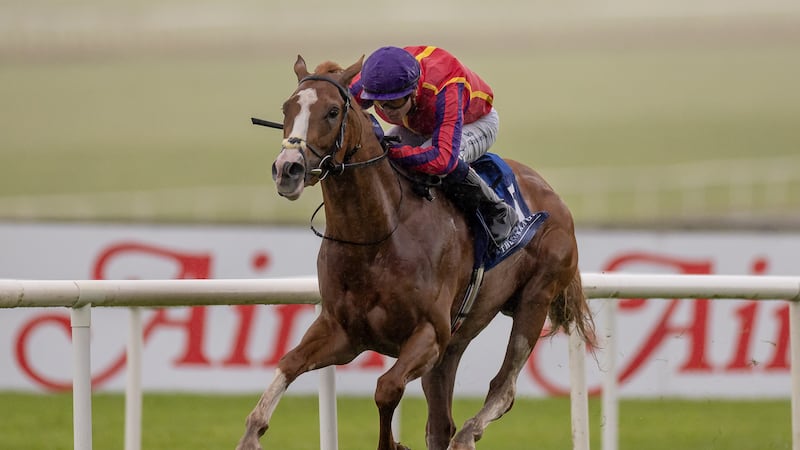The Galway festival can be a handy gauge of the national mood and could be again when it starts on Monday evening.
Synonymous with Celtic Tiger excess back in the day, Irish racing’s most distinctive fixture returns to post-pandemic normality in a context of broader economic worries.
In 2019, the last time full crowds were at the festival, just shy of 130,000 racegoers piled into Ballybrit over seven days.
That maintained a gradual slide in attendance levels since an official figure of almost 217,000 people crammed in at the height of Tiger excess in 2006.
RM Block
If that was a sign of the times, then Galway’s appeal is likely to come under the microscope this week with plenty wider implications likely to be taken from what happens.
Last week’s Horse Racing Ireland (HRI) statistics for the first of this year showed a 9 per cent dip in overall attendance figures.
That is reflective perhaps of people’s financial worries but more tangibly of there being no popular post-pandemic surge to go racing again.
If Galway’s singular appeal can’t reverse that, then longer-term fears will only cement it.
Defining that appeal has always been tricky. John B Keane called the Galway races a state of mind, a sufficiently vague summation to try and explain what really oughtn’t to work but always has.
Almost every other racing jurisdiction gets its biggest public interest from the best races or the most valuable.
Both Wednesday’s Galway Plate and the following day’s Galway Hurdle are worth €270,000, part of an overall €2 million prizemoney fund for the seven days.
Classic stars such as Grey Swallow have begun their careers on the flat around Ballybrit’s rollercoaster track.
However, the level of quality in comparison to an event like September’s Irish Champions Weekend comes up short and yet Galway’s hold on the popular imagination continues.
In terms of people through the turnstiles, Thursday’s Ladies Day programme always pulls a huge crowd although it is Friday evening’s action that has grown most over the last decade with younger racegoers piling into the city ahead of the bank holiday weekend.
The rate at which they come this time, especially with tales of sky-high hotel prices and a shortage of capacity, will be closely watched as the Galway executive hope for a return to normality in more ways than one.
One return to festival convention already assured though is that of mixed cards this week.
The pandemic resulted in even Galway having to bow to the need to split flat and jumps racing but the mixture of the two is likely to prove a crowd-pleaser.
Crowds are what on-course bookmakers rely on and layers will hope Galway continues to prove singular in terms of turnover.
In 2019 the ring at Ballybit bucked the trend with a total of €6.8 million bet, representing an increase on the previous year of almost half a million euro.
More recent evidence in the HRI statistics however suggests repeating that could be difficult with a 10.3 per cent drop in turnover for the first half of this year. In the same period, Tote Ireland turnover was down 12.8 per cent on 2019.
Punters chasing a profit at Galway in recent years have often put their faith in Willie Mullins.
The dominant National Hunt figure has been leading trainer at the festival for the last seven years.
In that period Mullins has saddled 71 winners in all, including a dozen each in 2017 and 2018. That dipped slightly to 10 in 2021 although included the Galway Plate-Galway Hurdle double with Royal Rendezvous and Saldier.
Mullins is once again a heavy favourite to dominate the week and underline how he has replaced Dermot Weld in the role of modern-day King of Ballybrit.
He has 11 declarations on Monday including half a dozen runners in the featured €110,000 Connacht Hotel Handicap.
Weld himself tries once again with last year’s winner Coltor in what is perhaps the most coveted prize of the year for amateur riders in Ireland.
Curragh maestro
However, it is Weld’s runner in the earlier Claregalway Hotel two-year-old maiden that may present the biggest conundrum of the day.
This is a race the Curragh maestro has dominated like no other over the years with no less than 24 previous winners.
Ordinarily, his representative this time, Tiverton, would be banker material. The Juddmonte colt had barely passed the post on his promising Curragh debut than hard-nosed backers were thinking of Ballybrit a month later.
There has been little ordinary about 2022 so far for the Weld team though.
Homeless Songs was brilliant in the Irish 1,000 Guineas in May but she is one of just half a dozen winners for her trainer on the flat this year. It is more than 40 days since the last of them.
That Tiverton managed such a promising debut effort in such a context is clearly encouraging. The colt that beat him, Proud And Regal, has since won last week’s Tyros Stakes. But the niggle remains about such unusual overall stable form.
Aidan O’Brien’s senior team hasn’t been firing on all cylinders either this season but his two-year-olds have. His newcomer, Cairo, a son of Quality Road, is the latest Ballydoyle newcomer and O’Brien is not averse to giving good horses a spin around Ballybrit.
Victory for Tiverton though could be one sign of a Galway festival getting back to normal.


















